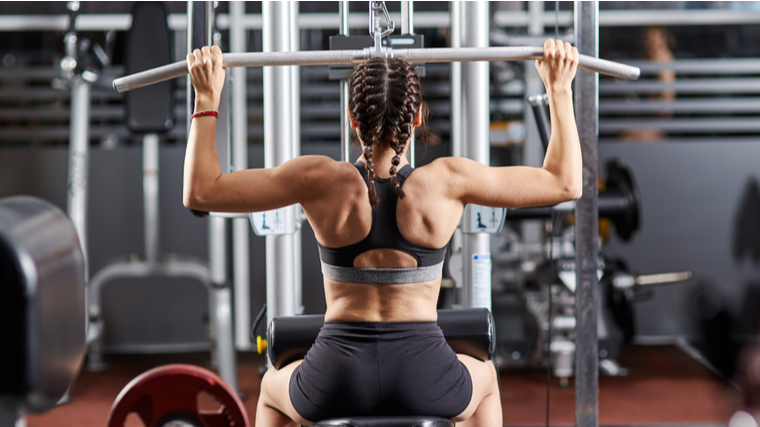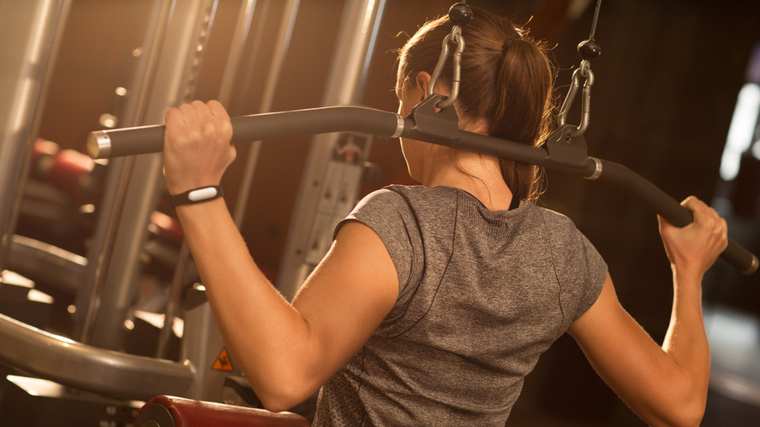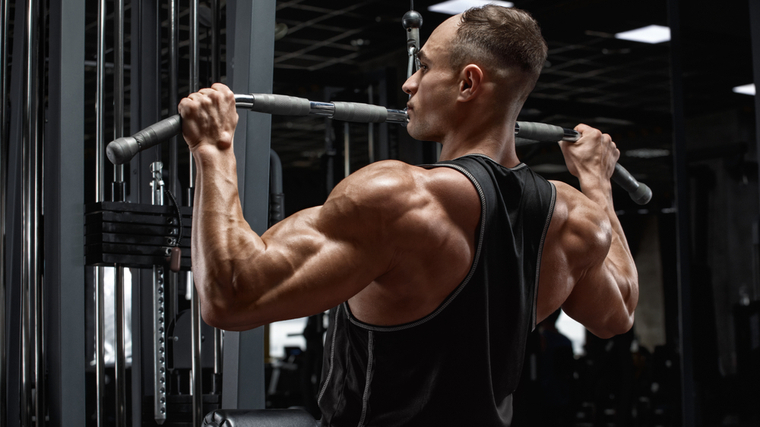Build Back Muscle and Work Up to a Pull-Up With the Lat Pulldown
Many gym-goers are well aware of the pull-up, but struggle to perform their first rep. While it may be fairly easy for some, for others, it is a much longer journey that can be shortened by spending time building the strength of the back musculature.
This is where the lat pulldown, sometimes called the front pulldown, comes in. It’s equally effective for beginners, intermediates, and advanced lifters because it can be performed with a variety of attachments and requires minimal equipment to execute. Here’s how to get the most out of this fundamental back-building exercise.
How to Do the Lat Pulldown
Because the lat pulldown uses a cable machine, it provides a great opportunity for muscle development. Master the basic movement, and then you can manipulate your body position and bar attachments to target your back muscles in a variety of ways.
Step 1 — Grab the Bar and Sit Down
Credit: martvisionlk / Shutterstock
Attach a wide bar to the pulldown cable attachment. Take a seat and adjust the kneepads to keep your lower body locked into place. Stand up and take hold of the bar wider than shoulder-width using a pronated grip (palms facing away from you).
Keep hold of the bar with slightly bent arms and use your bodyweight to descend into the seat. Shift your thighs under the pads and firmly plant your feet on the floor.
Form Tip: Stand with your thighs as close to the pads as possible before descending to help you better get into position smoothly. Locking your legs beneath the pads helps to provide stability and can reinforce a strict upper body position.
Step 2 — Pull the Weight to Your Chest

Remain in an upright position and create a very slight arch in your lower back, opening your chest towards the ceiling. Pull your shoulder blades together and down. Engage your core and pull the bar until it is underneath your chin or touches your chest without using any momentum.
Your torso should remain mostly stationary throughout the entire rep. Rather than just thinking “pull using every muscle available,” a great cue is to think about pulling your elbows out to the sides and down into the floor.
Form Tip: Imagine you are wearing pants that have back pockets and think about pulling your shoulder blades back and down towards those pockets. This scapular retraction and depression helps to engage more upper back muscles.
Step 3 — Raise Your Arms, Lower the Weight

Once you have reached the bottom, raise your arms under control, remaining seated. When your arms are fully stretched, release your shoulder blades from the pulled back position. Don’t shift or swing your upper body while your arms move.
Form Tip: When ascending back to the top of the movement, it is common to see people moving too fast. By not controlling the weight, you decrease stress on the back muscles and allow arms to take over. Take the time to feel your back muscles as they slowly stretch and fully lengthen. This body awareness creates a sense of mindfulness and helps you to use your back muscles more effectively in this and other exercises.
Lat Pulldown Mistakes to Avoid
While your lower body is set in place, your upper body is unsupported and simple mistakes in technique can reduce muscle activation and overall effectiveness.
Pulling the Bar Behind Your Neck
While behind the neck pulldowns are technically an exercise variation and not necessarily a “mistake,” it’s important to know that the movement can put you at risk of shoulder injury.

Due to the positioning of the shoulder joint, you may find yourself with some discomfort and irritation of the shoulders. (1)(2) Avoid this movement altogether and keep the bar in front.
Avoid It: Lifters often use the behind the neck pulldown thinking that it targets the back muscles differently. However, research has shown that this variation is no more effective at training the lats than your standard lat pulldown, yet has a higher potential for injury. (3)
Gripping the Bar Too Wide
Some lifters use an extremely wide grip, often at the extreme ends of the bar, in the hopes that it will help to build wider lats. Unfortunately, “wide grip = wide lats” doesn’t pan out.

Research has shown that the wide-grip variation is not more effective than the standard lat pulldown for training your lats. (4)
Avoid It: Maintain a standard grip, slightly wider than your shoulders. To build a wider back, focus on performing the exercise properly, contracting the muscles, and achieving a complete stretch.
Swinging Your Torso
Some lifters perform the lat pulldown like a fish out of water, with their whole upper body swaying back and forth. In some cases, you will even see their lower body come up off the seat. This is not the way to get results.

Avoid using any weight that causes you to sway excessively. This instability of your torso will displace stress from the muscles you want to target, which will take away from the effectiveness of the exercise.
Avoid it: Engage your core musculature and flex your abs while imagining being “stuck in the mud.” You want to be so stable that if someone tried to shove you from any angle, you remain in position.
Benefits of the Lat Pulldown
The benefits of the lat pulldown begin with its simplicity in set up and potential to be progressed (made more challenging) or regressed (made easier) beyond simply increasing or reducing weight.

Pulldowns can help to improve a range of qualities in the upper body such as muscular strength, muscle hypertrophy, muscular endurance, and performance.
Constant Tension
The use of the cable places a significant amount of stress on the muscles due to the constant tension being placed throughout the entire range of motion. This makes it an invaluable exercise for lifters working to build size, because a greater amount of time under tension has been shown to stimulate more muscle growth. (5)
Beginner-Friendly
The pull-up and chin-up will always reign as kings for upper body vertical pulling exercises, but the lat pulldown can still be a great exercise for lifters new to training. You may not be strong enough to perform a pull-up, but the lat pulldown will assist in developing your back musculature as you become stronger over time.
The lat pulldown places relatively less demand on your body, which means you can train with a considerable amount of volume by increasing your sets and reps each week, making it a great exercise to build muscle and strength in your back.
Muscles Worked by the Lat Pulldown
The lat pulldown works a host of muscles on your back, including the large lat muscles and the entire upper back.

This pulling movement, like most back exercises, also provides some stimulation to the forearms and biceps.
Latissimus Dorsi
The lats are the wide muscles on either side of your back. They have two functions — to bring the arm in closer to your body when it is out to the side and to bring the arm closer to the body when it is out in front. The path of your elbow and upper arm follows both of these movements, which is why pulldowns hit target the lats efficiently.
Upper Back
The trapezius, rhomboids, teres, infraspinatus, and posterior deltoid work together to form the upper back musculature. They control a variety of movements at the scapulae (shoulder blades), including raising and lowering, pinching together, extending, and pulling downwards.
Biceps Brachii
The biceps are recruited during nearly all back exercises, particularly pulldowns as the weight is lifted and your arm bends and straightens at the elbow. “Lifting with the arms” can occur when your elbows are bent too quickly and the biceps move the weight, rather than lifting with your back muscles by focusing on moving your upper arm at the shoulder.
Forearms
The forearm muscles, specifically the wrist flexors on the palm-side of the arm, are heavily activated to secure your grip to the bar while lifting and lowering the weight. Some lifters may have their grip strength become a limiting factor when pulldown weights get excessively heavy. Progressing gradually, or considering lifting straps, should help to avoid the problem.
Who Should Do the Lat Pulldown
A number of lifters can make use of the lat pulldown within their programming due to its versatility, simplicity in its set up, and ability to provide a significant amount of tension on the majority of the back muscles.
Training for Muscle
You would think by the name of the exercise that it would specifically target the lats, yet, most people are surprised that research has shown it actually trains the majority of your back muscles very effectively. (6)
Not only can you use relatively heavy weights, since this exercise recruits almost every major muscle group in your back, but you also don’t need to use multiple exercises within your workout which makes the lat pulldown an ideal, time-efficient choice.
How to Program the Lat Pulldown
To maximize muscle development and strength, a variety of rep ranges can be used on the lat pulldown. However, you should never use a weight so heavy that it takes away from executing the exercise properly.
Too many lifters pile on the weight and swing their torso to get it moving, thinking they’re overloading their back when all they’re doing is stressing their joints, not their muscles.
Moderate Weight, Moderate Repetition
To maximize muscular hypertrophy, training within a close proximity to muscular failure in the six to 12 rep range for three or four sets is the most effective way to program this exercise.
Light Weight, High Repetition
The use of the cable machine creates constant tension, increasing the muscle-building stimulus. This can be further exploited at the end of a workout to fully exhaust all muscle fibers. Using two to three sets of 12 to 20 reps will serve you best.
Lat Pulldown Variations
The lat pulldown is a highly adaptable exercise that can be used in a variety of ways by simply attaching a different handle or attachment.
V-Bar (Neutral-Grip) Pulldown
The neutral-grip variation uses a V-bar attachment to allow your palms to face each other. This adjusted grip position provides you with a mechanical advantage which allows you to lift more weight.
This is a great variation to use for working the surrounding muscles of the scapulae through a full range of motion while strengthening your back in the process.
Supinated-Grip Pulldown
The supinated variation uses a standard long bar with your palms facing you. The key difference with the supinated lat pulldown is that it trains the biceps more than the standard pulldown, with the lats being trained more in the standard movement. (7)
This can be seen as a similar relationship between the pull-up and chin-up, with the chin-up emphasizing the biceps and the pull-up emphasizing the lats
Single-Arm Pulldown
Attaching one single handle to the pulley and training each arm individually allows you to identify any muscular imbalances between sides of the body. By focusing on each side independently, you can strengthen and correct any differences.
The free movement of a single handle also allows you to use a variety of hand positions, either neutral (palm facing you), supinated, pronated, or rotating during the movement. Each hand position will slightly alter muscle recruitment and can reduce stress on elbow or shoulder joints.
Lat Pulldown Alternatives
Once you have built a solid foundation of strength on the lat pulldown, your back will be better developed to progress into more advanced exercise alternatives. It is important to note that the lat pulldown can still be used within your workouts, but the order of priority may change.
For example, you may perform more challenging exercises earlier in your back workout when your strength, focus, and energy is higher and train pulldowns later in the workout.
Pull-Up
The goal of successfully performing a pull-up (or chin-up) should be on every lifter’s mind since it works the entire back, can be done nearly anywhere, and is so easy to progressively overload.
Mastering this fundamental bodyweight exercise can benefit any lifter or athlete.
Assisted Pull-Up
The assisted pull-up, either with a machine or using resistance bands, is a great exercise to transition from pulldowns to full pull-ups This exercise allows you to practice the correct positioning of the upper body and reinforce technique that will be required when performing a pull-up.
Use this exercise to focus on feeling the back musculature throughout the eccentric (lowering)and concentric (lifting) portions of the lift while also practicing your ability to engage your core and keep your torso stable.
FAQs
Is there a “best” pulldown attachment to use?
All of the variations of the lat pulldown are very effective exercises that should be used across multiple phases of training. To maximize overall back development, it would be a good idea to rotate one or two of these variations into each phase of your programming.
This will help decrease any muscular imbalances that may occur when solely focusing on one exercise, but can also help you identify any weak points that you may have when using certain variations.
How long until I will be able to perform a bodyweight pull-up?
Every person will progress at their own ability based on a number of individual factors, so there is no set timeline to achieving your first bodyweight pull-up. However, if you are incorporating a combination of the above pulldown variations into your workouts, this will give you the best opportunity at finally achieving that bodyweight pull-up or chin-up faster.
While the pull-up may be considered as the ultimate goal, once you feel that your back is strong enough, starting with the chin-up alternative will allow you to practice the same general technique involved in the pull-up, but it is relatively easier to perform due to the slight mechanical advantage using a supinated grip.
Perfect the Pulldown
The lat pulldown is a reliable back-builder, perfect for beginners and advanced lifters. It should be a staple in any back routine, whether you’re on the way to your first pull-up or can knock them out by the dozen.
References
- Pagnani, M. J., & Warren, R. F. (1994). Stabilizers of the glenohumeral joint. Journal of shoulder and elbow surgery, 3(3), 173–190. https://doi.org/10.1016/S1058-2746(09)80098-0
- Durall, Chris & Manske, Robert & Davies, George. (2001). Avoiding Shoulder Injury From Resistance Training. Strength & Conditioning Journal. 23. 10. 10.1519/00126548-200110000-00002.
- Sperandei, S., Barros, M. A., Silveira-Júnior, P. C., & Oliveira, C. G. (2009). Electromyographic analysis of three different types of lat pull-down. Journal of strength and conditioning research, 23(7), 2033–2038. https://doi.org/10.1519/JSC.0b013e3181b8d30a
- Andersen, V., Fimland, M. S., Wiik, E., Skoglund, A., & Saeterbakken, A. H. (2014). Effects of grip width on muscle strength and activation in the lat pull-down. Journal of strength and conditioning research, 28(4), 1135–1142. https://doi.org/10.1097/JSC.0000000000000232
- Burd NA, Andrews RJ, West DW, et al. Muscle time under tension during resistance exercise stimulates differential muscle protein sub-fractional synthetic responses in men. J Physiol. 2012;590(2):351-362. doi:10.1113/jphysiol.2011.221200
- Ronai, Peter. (2019). The Lat Pulldown. ACSMʼs Health & Fitness Journal. 23. 24-30. 10.1249/FIT.0000000000000469.
- Lehman, G. J., Buchan, D. D., Lundy, A., Myers, N., & Nalborczyk, A. (2004). Variations in muscle activation levels during traditional latissimus dorsi weight training exercises: An experimental study. Dynamic medicine : DM, 3(1), 4. https://doi.org/10.1186/1476-5918-3-4
Featured Image: lunamarina / Shutterstock
Comments are closed.